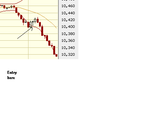Hello Everyone.Could someone please help me,i seem to struggle in finding a stop loss that i can execute.I Spreadbet the Dow using 5 min chart for entry and average trades is ratio is around 3 to 1 and sometimes i can increase this.My problem is that i give all my gains back in a single trade so im struggling to move forwards.It seems i have a problem getting out of a losing trade until its too much pain to take,i understand this to be a problem with not accepting that i'm wrong.Iam now at the stage that if i trade and don't identify and execute a stop loss then i'll continue to loose money.
I've tried different stop loss format eg, 10 points from entry also if price closes or opens above or below a previous 5 min candlestick,and have also gone to a timed stop loss,but have failed to implement these for a period of time.
So what i'm hoping to find is a suitable stop loss criteria that i can use on the Dow.I have enclosed a chart on the dow today where i entered to buy at 10,400,i was 10 points in profit and then the market came back down as i thought at the time to retest the 10,400 level,i did not consider at this time to exit but i quickly found that this was wrong when the price drove below,i then started discounting what i was seeing because i expected a bounce up at anytime,im breaking another rule because im trading what i think and not what i see.Anyway i eventually got out at im sorry to say 10351.Im hoping that someone could come up with a suggestion for a fixed point stop loss for evey trade on the Dow.Please excuse me if this request seems a bit strange but i will be very appreciative of any suggestions,thank you all.
Fantastic website this.
I've tried different stop loss format eg, 10 points from entry also if price closes or opens above or below a previous 5 min candlestick,and have also gone to a timed stop loss,but have failed to implement these for a period of time.
So what i'm hoping to find is a suitable stop loss criteria that i can use on the Dow.I have enclosed a chart on the dow today where i entered to buy at 10,400,i was 10 points in profit and then the market came back down as i thought at the time to retest the 10,400 level,i did not consider at this time to exit but i quickly found that this was wrong when the price drove below,i then started discounting what i was seeing because i expected a bounce up at anytime,im breaking another rule because im trading what i think and not what i see.Anyway i eventually got out at im sorry to say 10351.Im hoping that someone could come up with a suggestion for a fixed point stop loss for evey trade on the Dow.Please excuse me if this request seems a bit strange but i will be very appreciative of any suggestions,thank you all.
Fantastic website this.

